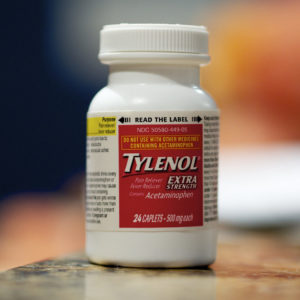Acetaminophen Dose Warning Issued by FDA Over Liquid Infant Drugs

New liquid acetaminophen products for infants have federal health officials concerned about accidental Tylenol overdoses and dosing confusion by parents.
The FDA issued a consumer update on December 22, warning parents that a number of new liquid acetaminophen products for infants have different potency than older liquid acetaminophen medications.
The agency fears that parents and caregivers of infants and children may accidentally give a child too much of the drug because they are used to the dosing sizes of older brands of liquid acetaminophen drops. They may also give too little of the drug, making it ineffective.

Tylenol Autism Lawsuit
Side effects of Tylenol may cause autism and ADHD among children exposed during pregnancy. Find out if your family may be eligible for a Tylenol autism or ADHD settlement.
Learn More About this Lawsuit See If You Qualify For CompensationAcetaminophenis a pain killer and anti-inflammatory medication found in a number of over-the-counter and prescription drugs. It is also widely marketed for use among infants and children for the treatment of fever, aches and pain.
Medication errors with acetaminophen led to 14 deaths and 74 injuries from 2000 to 2010 in children under the age of 13, according to the FDA.
In response to concerns raised by the FDA over the high potency of many infant liquid acetaminophen products, a number of drug makers have reformulated their medications to be more diluted. They were previously sold in 80 mg/0.8 mL and 80 mg/mL concentrations. However, a new version of the medications has been diluted to 160 mg/5 mL. The previous versions came with droppers for dosing, while many new one comes with an oral syringe.
The change was voluntary and not all drug manufacturers have adopted it. This means that a number of concentrations are now on store shelves, which could confuse parents.
The FDA is urging parents to carefully read the dosing instructions and medication guides of this and all other drugs, and to use the dosing device included in the packaging.
Even in cases where a product changed, the packaging often changed very little, which could lead to confusion if the person bought older versions of the drug and then bought the new version not realizing there was a difference.
One example of this the FDA held up was Little Fevers by Little Remedies. Both boxes say “New!” on the front and are very similar in design, but are of different concentrations.
The FDA did not provide a full list of the products that changed their formulations. Instead, telling parents to read every medication guide and dosing instructions every time a purchase is made.
There is no recommended dosing for children under the age of two, so parents should also consult their physician any time they intend to give acetaminophen to infants, the agency warned.
According to the FDA, acetaminophen overdose has been a leading cause of liver failure in the United States, resulting in more than 50,000 emergency room visits, 25,000 hospitalizations and over 450 deaths annually.
Due to the risks associated with receiving too much acetaminophen, an FDA advisory panel was convened in May to make recommendations about new warnings or other regulatory actions. The panel recommended that dosing instructions be based on a child’s weight instead of their age.
Stronger warnings about the potential risk of liver failure from acetaminophen have also been added to all products over the past year, including clearer indications about what products contain acetaminophen as the active ingredient to avoid the risk of overdose.
Get more articles like this sent directly to your inbox.
"*" indicates required fields





0 Comments